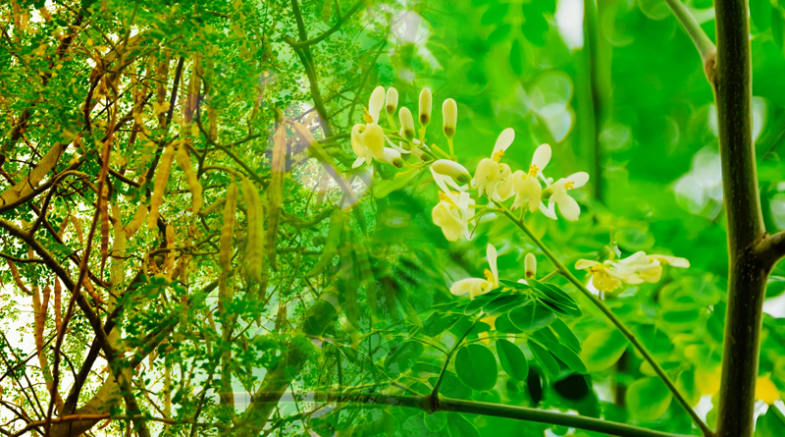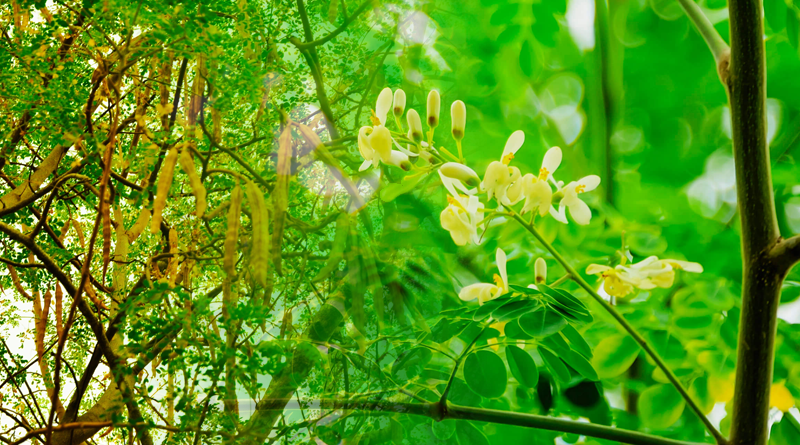All parts of moringa are consumed as food. It is a highly valued vegetable tree with a variety of potential uses.

Moringa is a small to medium evergreen or deciduous tree that can grow to a height of 10–12 m. It has a spreading, open crown, typically umbrella-shaped. The roots are deep. The bole is crooked, generally one-stemmed but sometimes forked from the base. The bark is corky and grey. The branches are fragile and drooping, with feathery foliage.
The immature green pods of the Moringa tree, called “drumsticks,” are commonly consumed in different areas of Pakistan. It is distributed in many countries of the tropics and subtropics, is well known for its medicinal properties but rather less known for its anti-diabetic activities. Administration of methanol extract of the root bark of M. oleifera (1 and 1.5 g/kg) showed a significant fall in fasting blood sugar levels.
At a dose of 1.5 g/kg, a 43% fall in blood sugar level was observed at the 5th hour of medication, compared to a 45% fall exhibited by tolbutamide (200 mg/kg). Glucose tolerance tests in albino rats also showed significant activity.
Medicinal uses:
The root has been used internally in folk medicine for gastrointestinal complaints, cardiac complaints, high blood pressure, dizziness, and colds. It is also used to heal wounds and inflammation. The seeds are used in neuralgia, inflammations, intermittent fevers, and ophthalmopathy.
Flowers are used as aphrodisiacs. The leaves are rich in vitamins A and C and are used as anti-inflammatory, anodyne, anthelmintic, and ophthalmic agents. Moringa showed anticonvulsant, analgesic, and sedative activity
Nutritive properties of different parts of Moringa
All parts of moringa are consumed as food. It is a highly valued vegetable tree with a variety of potential uses.
Leaves:
The plant produces leaves during the dry season and during times of drought and is an excellent source of fibre, fat protein, minerals, vitamins , amino acids, phytochemicals, alkaloids, glycosides, and green vegetables when little other food is available.
Moringa is mainly grown for its leaves in Africa but is much appreciated for its pods in Asia. Leaves, pods, roots, and flowers can be cooked as vegetables. The roots have been used as a substitute for horseradish, but they may be slightly toxic.
They are generally cooked (boiled or pan-fried) and eaten like spinach or put in soups and sauces. Moringa leaves are also eaten as a salad or dried and ground to make a very nutritious leaf powder. Moringa leaf powder is used to aid the restoration of infants suffering from malnutrition.
Flowers
Moringa flowers are used to make tea, added to sauces, or made into a paste and fried. The young pods are prepared and taste like asparagus. Older pods can be added to sauces and curries, where their bitterness is appreciated. Flowers contain calcium, potassium, and amino acids. They also contain nectar.
Seeds
The immature seeds can be cooked in many different ways, while the mature seeds are roasted and eaten like peanuts. Moringa seeds contain about 30–40% of an edible oil (ben oil), which is used for salad dressing and cooking and can replace olive oil. Ben oil is resistant to rancidity and provides substantial amounts of oleic acid, sterols, lectins, and saponin.
Pods:
Pods are a rich source of fibre, lipids, non-structural carbohydrates, protein, and ash fatty acids like oleic acids, linoleic acids, palmitic acids, and linolenic acids .
